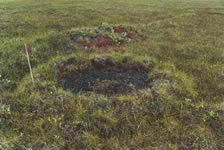
Biocomplexity of Frost-Boil Ecosystems
Project Summary
This project seeks to understand the complex linkages between biogeochemical cycles, vegetation, disturbance, and climate across the full summer temperature gradient in the Arctic in order to better predict ecosystem responses to changing climate. We focus on frost-boils because: (1) The processes that are involved in the self-organization of these landforms drive biogeochemical cycling and vegetation succession of extensive arctic ecosystems. (2) These ecosystems contain perhaps the most diverse and ecologically important zonal ecosystems in the Arctic and are important to global carbon budgets. (3) The complex ecological relationships between patterned-ground formation, biogeochemical cycles, and vegetation and the significance of these relationships at multiple scales have not been studied. (4) The responses of the system to changes in temperature are likely to be nonlinear, but can be understood and modeled by examining the relative strengths of feedbacks between the components of the system at several sites along the natural arctic temperature gradient.
We examine three aspects of biocomplexity associated with frost-boil ecosystems. They are: complexity associated with self-organization in frost-boil; complexity associated with interactions between biogeochemical cycles, cryoturbation, and vegetation; biocomplexity across spatial-temporal scales.
We propose to answer six questions related to the biocomplexity of frost-boil ecosystems: (1) How does the self-organization associated with frost boils occur? (2) How does the frost heave affect the soil biogeochemical processes within and between the frost boils? (3) How do frost heave and biogeochemical processes affect plant communities? (4) How do the biological processes in turn feed back to control frost heave? (5) How do interactions between biogeochemistry, cryotrubation and vegetation change along the existing arctic climate gradient? (6) How do the complex patterns associated with frost boils affect the tundra systems in a hierarchy of spatial-temporal scales?
Related Documents:
- Biocomplexity of Frost-boil Ecosystem project proposal (328k PDF)
- VECO field arrangement and schedule (90k PDF)
- Project budget (48k PDF)
